Foreign Insulators
by Marilyn Albers
Reprinted from "Crown Jewels of the Wire", November 1988, page 17
Come climb aboard my magic carpet for a trip to the USSR, compliments of Don
Fiene of Knoxville, Tennessee, who sent in the following account of his most
recent adventure.
SOVIET INSULATOR REPORT, 1988
by Don Fiene
The spirit of GLASNOST was stronger in 1988 in the Soviet Union than in any
previous year -- a year which also marked the one-thousandth anniversary of the
establishment of Christianity in Russia. Whether these things have any
relationship to the successful liberation of insulators, I cannot say -- but this
year's trip to the USSR was my most successful one yet from the point of view of
the Great Hobby. I led a group of fifty people (ranging in age from fifteen to
eighty) from Leningrad to Moscow via Yalta, Odessa and Kishinev (the capital of
Moldavia), with an overnight stay in Zurich on the return leg. The trip lasted
eighteen days -- June 5-22.
This year I found nothing in Leningrad, nor did I run into any teen-age boys
who might have been willing to trade insulators and porcelain signs for some of
the army insignia and small American flags I had brought with me.
When we landed at the airport in Simferopol, Crimea, we were met by two local
college boys who acted as volunteer guides for our group, accompanying us on the
sixty-mile ride south over the mountains to the sub-tropical Black Sea coast.
During the bus journey, I showed these lads, one of whom lived in Yalta, my
insulator photographs. They practically fell out of their seats laughing over
this strange American hobby -- and they went into total rapture when they came to
the photo of me climbing a pole like a cat, back in the days when I was even
more of a hippie than I am now. They swore to me that within twenty-four hours
they would get me all the insulators I wanted. We were staying in Yalta for
three days at a first-class resort; the water of the sea was crystal clear.
During supper the next night word was passed to me that my comrades were
waiting for me in the lobby with a huge wooden box. I rushed out to meet them.
The box was indeed huge, full of insulators, and almost too heavy for one
person to lift. I was at once ecstatic and terrified; I had to have them all,
yet how could I wrestle those suckers through five more airports (both arriving
and leaving), on top of all other baggage. (My wife, Judith, was traveling with
me.) Finally I got serious and tossed out two transformer insulators and reduced
the weight by half. However, I kept a ten-inch-diameter sombrero of light-green
glass, with Cyrillic writing all over it, including the desired phrase, "Made
in the USSR." There were also two pair of smaller green glass power
insulators; one pair was close to CD 540 (being 3-1/8" x 4-1/8") and
the other pair was CD 247.5. These were duplicates for me, and like gold in the
bank.
Probably the most interesting of the fourteen items in the box was a small
white porcelain 3-5/16 high, being a blue underglaze mark of the Imperial
two-headed eagle. (See accompanying drawing and photo; there is also a picture
of the same insulator in CD, June 1981, page 5, but I cannot find the assigned
U-number). This is the first probably pre-revolutionary Russian insulator I have
discovered.
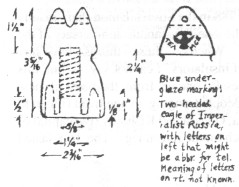 |
Don, the little white porcelain insulator with the holes through the ears has
been catalogued in the Style Chart as U- 1784. It is pictured on page 5 of the
June, 1981 issue of Crown Jewels, as you said. In that article was your account
of the insulators you brought back from the USSR in 1978 and you loaned me
several of them, including the U- 1784, so I could take dimension and get shadow
profiles. That particular specimen had only an incuse number 5 on the side of
the crown. How interesting to find one marked with the Imperial two-headed
eagle! Your new find is just a tad taller than the drawing in the U-Chart, and
so won't warrant a new assignment You can simply refer to it as "similar
to" U- 1784. The other two porcelains you included drawings of here may be
up for new U-numbers. -- MARILYN
|
Other white porcelain items in the box included a small knob 15/16" x
7/8"; a piece similar to U-1633, except 2" x 2-5/8"; an unmarked piece
similar to U-1654, but 2-3/8" x 3-1/4"; an item similar to U-1710,
but 3" x 4-3/8", with an incuse circle on the crown bearing the last
two digits on the date. There was also a heavy tapered cylinder used in
anchoring trolley-car support wires to buildings and poles. (See drawing of one
of the same size in Crown Jewels, September, 1984, page 7). Another insulator
probably used for the same purpose was an untapered cylinder 2-3/4" x 2-7/8". It and the previous item bear the same blue underglaze mark: 'Made in
the USSR" (CAEAHO B CCCP) in an arc, within which is an insulator symbol
containing a number, and below that is the year.
I gave the boys all my military junk and the flags, which they were glad to
have, but they certainly were not looking for payment. They told me they had
obtained almost all the insulators from an old war veteran who worked as a guard at
the main power station in the city. He liked the idea of helping out an American
who had a hobby he could relate to.
The next day (our last in Yalta), the boys introduced me to the guard. He was
afraid to let me inside the complex, but he took one of the boys back; they soon
returned with another insulator for me -- a giant brown porcelain piece that
would have made a good boat anchor. I took it out of politeness. (See
accompanying drawing below). The boys told me the guard wanted to give me three
more insulators -- large, and of amber glass, but they were in use. He would not be
able to change them out until the new shift came on (in which he had a friend)
at midnight. I thanked the guard and told him I would return. However, the boys
told me there was something strange about the guard. He was too dangerously
careless about his job and probably he was an alcoholic also. They advised me
not to go back; probably the guard would be caught by one of his superiors and
then I would get in trouble, too. I took their advice, but with regret.
I found no insulators either in Odessa or Kishinev, and in Moscow I had only
one opportunity to go hunting -- on our next to last night in the city. My
college-age son was along on this trip, too. (I got three free fares worth $2500
apiece from the tour company for rounding up fifty passengers). Anyhow, Bruce
and I took a four or five mile hike, on a nice cool rainy evening, along the
main tracks leading out from Riga Station. There were thousands of desirable
glass insulators overhead, but none on the ground. However, I did find two
broken crossarms in a ditch. From one I took another U-1654 and from the other I took
the medium-sized brown porcelain power insulator described here in an
accompanying drawing. I could have had another one, but left it. I was really
just looking for glass. Toward the end of our hike, I found three high-voltage
warning signs covered with tar and creosote (Nice for the suitcases.) Two were porcelain.
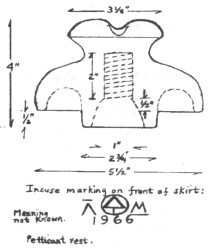
I felt almost depressed over these marvelous new finds. How could I ever get
all that junk out of the country? True, I had gotten through every X-ray check
at the internal airports we had passed through, but Moscow's International
control was a different story.
My son was kind enough to take my heaviest porcelain insulator in his duffel
bag. This represented a sacrifice, as he was hoping to smuggle out an almost
complete navy uniform. The insulator might call unwanted attention to him.
However, as it turned out, the customs personnel were not interested in any of
us. They let all fifty of us go through without opening a single suitcase or
even looking at any of them on their X-ray screens. Now that may not be
GLASNOST, but I give three cheers for it anyhow. Meanwhile, over the past ten
years, I have taken seventy-five or more insulators out of the USSR, retaining
about sixty for my collection. If I said it has been a piece of cake all the
way, I'd by lying -- but it's gotten easier lately. Regardless, no one but me could
have done it. I hate to brag, but let's face it....
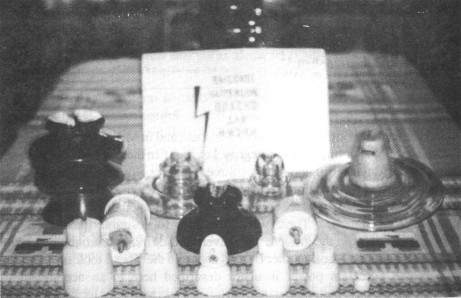
Some of the Soviet-Russian insulators obtained on Don's trip to the USSR in
June.
(Picture on Next Page to the Right) The sign with the skull is rusted sheet
iron, partially restored (should be black & white with red arrow). It says:
DO NOT CLIMB -- IT KILLS. The porcelain sign at lower right says: HIGH VOLTAGE
-- DANGER. At the bottom of the sign is a telephone number and the arrow is red.
The sign at the top in the photo (Below) is white on blue and identifies
"9th
Soviet St." The remaining signs, likewise porcelain, were all found in old
apartment houses in Leningrad.
Upper Left: black on white, Respect the Work of
the Janitor -- Be Neat.
Center: black on white, List of Rules for the Janitor
Lower Left: blue on white, Conserve Heat (that is, close the door).
Bottom:
white on blue, List of Apartment Numbers off Stairway #6.
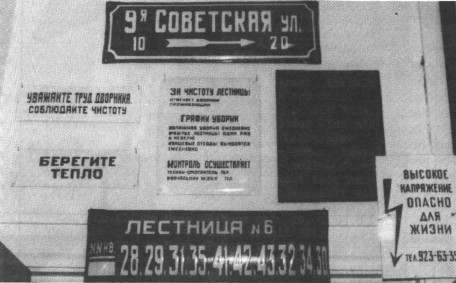
Thanks very much for sharing with us, Don. It is great fun imagining you in
all those various situations trying to scarf up insulators. And yes, I think
you're right, no one but you could have done it!
In my August column, I promised to show you three foreign signs. The ones
from the USSR you have already seen here. Don brought back a duplicate of the
black and white sign with the red arrow and this is now in my collection. It is
neat.
The sign to the right is from France. It is made of heavy cast aluminum and
red paint has been applied only to the background, causing the letters and the
border to appear silvery. The words read "ELECTRICITY OF FRANCE - IT IS
ABSOLUTELY FORBIDDEN TO TOUCH THESE LINES (or wires) EVEN IF THEY HAVE FALLEN TO
THE GROUND. DANGER OF DEATH." I have this same sign in two smaller sizes,
both of which are meant to attach to power line poles. One is round and the
other is oval. The words are the same.
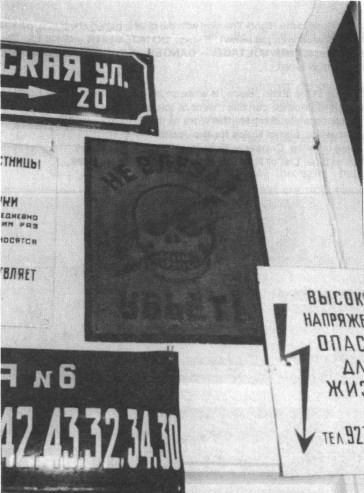
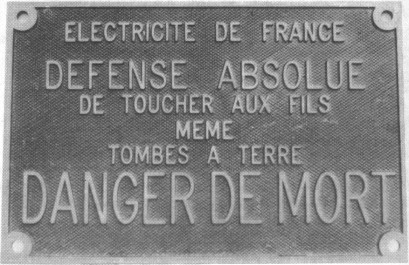
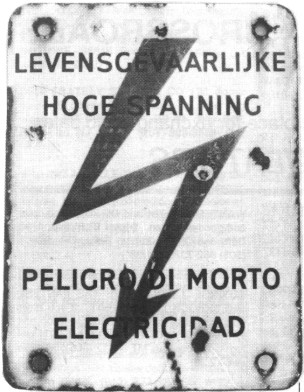
The sign pictured above is of sheet iron with a white enamel background
and black letters. The arrow is red. The words at the top are Dutch and they say
"LIFE THREATENING -- HIGH VOLTAGE." I'm assuming, but I'm not sure, that
the rest of the words are also Dutch. Loosely translated they are "DANGER
OF DEATH BY ELECTROCUTION."
Speaking of France, let's go there next time, and see what kind of a time was
had by Andy Gibson and Bill Snell last summer when they took a trip through
France, Belgium and Germany. These young fellows, both of Rochester, New York,
reported seeing some amazing insulators!
|
